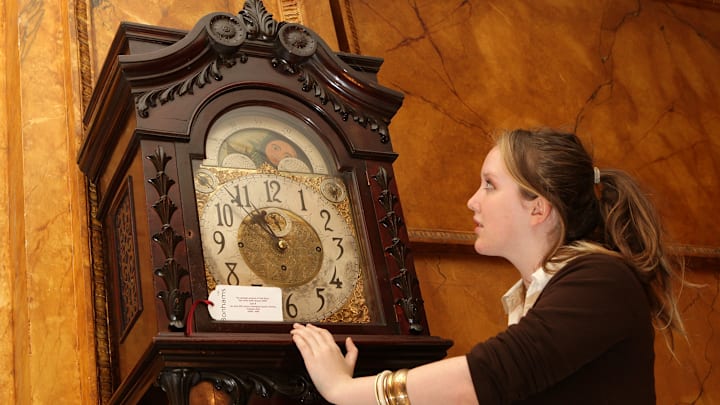Thanks to smart watches and smartphones, analog clocks aren’t quite as common a sight as they once were. One that still manages to make an impression is the grandfather clock, a vertically imposing timekeeper that feels more like furniture. A pendulum marks time; the case, often ornate, serves as a conversation piece.
What does a clock of this type have to do with grandfathers? Was it named after one grandfather in particular? Not exactly.
The Origins of the Grandfather Clock
The term grandfather clock has very little to do with any kind of familial inspiration, though the story behind it is that rare etymological find that can be easily traced to a single source: a musician.
According to the Oxford English Dictionary, the first known reference to a grandfather clock came in 1876, when songwriter Henry Clay Work composed a piece of sheet music titled “Grandfather’s Clock,” or “My Grandfather’s Clock.” In it, Work relates the story of a clock “taller by half than the old man himself” that “stood 90 years on the floor.” The time piece “kept the time, with a soft and muffled chime” as his grandfather began slipping away, but “stopp’d short, never to go again” when he passed on.
Work was apparently prompted to compose the tune after visiting the George Hotel in North Yorkshire, England. While there, he came across a non-working clock in the lobby. According to the hotel staff, the clock had previously been owned by two brothers who once operated the hotel. When one brother passed, the clock slowed; when the other brother died, it stopped immediately.
The story is unlikely to ever be corroborated and may have simply been an apocryphal tale told for the amusement of hotel guests. True or not, it inspired Work to write his song, which took off in a major way. “My Grandfather’s Clock” was a massive hit and the term became synonymous with this specific type of clock.
Obviously, such clocks existed before Work wrote a song about one. So what did everyone call it before that?
Longcase Clocks
Prior to Work popularizing a colloquial term, grandfather clocks were known as longcase or tall case clocks. Although pendulum mechanisms had been used in clocks—a development often credited to Dutch astronomer Christiaan Huygens circa the mid-1600s—it wasn’t until William Clement began adorning them in elaborate cases later on in the 17th century that longcase models took off.
The matter was one of practicality. Though longer pendulums were better for keeping accurate time, they were not terribly aesthetically pleasing. A longcase clock allowed for the pendulum to be encased in a visually attractive arrangement. The upper part, or hood, contained the clock itself; the middle, or waist, held the pendulum; the base provided support as well as a place for the clock's weights.
It’s not totally clear whether Clement invented the longcase clock or simply became renowned for his craftsmanship. He is often given credit, however, for improving the timekeeping accuracy of pendulum clocks.
Initially, such clocks were the purview of wealthier classes, as the labor and materials needed necessitated a hefty price tag. In Pennsylvania, German settlers considered it a sign of success and prosperity. Over time, however, the clocks began appearing in a growing number of homes and were soon framed as family heirlooms. Their status was probably enabled in part by their permanence—a grandfather clock is no easy thing to relocate—as well as their workmanship.
A more compact pendulum clock earned a nickname around the same time: Perhaps inevitably, it was known as a grandmother clock.
Get Answers to More Big Questions:
Have you got a Big Question you’d like us to answer? If so, let us know by emailing us atbigquestions@mentalfloss.com.
